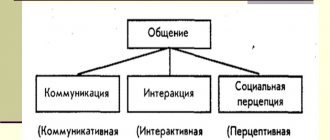Concept of communication
Communication is a complex, multifaceted process of establishing and developing contacts between people, generated by the needs for joint activities.
Throughout life, a person is involved in the process of communication. Depending on age, gender, occupation, goals, etc. one or another type of communication plays a leading role. Any communication with any person is subject to its own complex laws of an objective and subjective nature. Knowledge of these patterns is an indispensable condition for the effectiveness of both communication itself and any human activity. In addition, there are a number of professional activities in which the communication process plays a leading role.
The problem of communication, considered as one of the main psychological categories, is an ambiguously interpreted concept. There are many definitions of communication in the scientific literature, which is due to the complexity and versatility of this phenomenon. Psychologists and philosophers are interested in various aspects of its manifestation (information exchange, psychological interaction and mutual influence, mutual understanding and relationship). Much attention is paid to the consideration of communication as an information process - the reception and transmission of information. An important direction in the implementation of the information aspect of communication is the consideration of issues of people’s understanding of each other, the perception of man by man. There are different approaches to defining the concept of “communication” (Table 1).
Table 1
Explication of the concept of communication as interpreted by various authors
| Author | Definition of communication |
| A.V. Petrovsky | “Communication is a complex, multifaceted process of establishing and developing contacts between people and groups, generated by the needs of joint activities”[1] |
| N.I. Konyukhov | “Communication is one of the universal forms of personal activity (along with cognition, work, play) manifested in the establishment and development of contacts between people, in the formation of interpersonal relationships and generated by the needs for joint activities” [2] |
| A.A. Bodalev | “Communication is the interaction of people, the content of which is the exchange of information using various means of communication to establish mutual relationships between people”[3] |
| V.M. Sokovnin | “Communication is interaction, the purpose of which is for one subject to change the intentions, views, beliefs, actions, and generally behavior of another subject, either in his own interests or in the interests of society”[4] |
| M.V. Gamezo, I.A. Domashenko | “Communication is a connection between people, as a result of which one person influences another”[5] |
In the most general form, communication can be considered as a form of life activity. It acts as one of the most important conditions for identifying and revealing the best sides of a personality, the formation of its consciousness and self-awareness, and a stimulator of its development. Communicating with other people, analyzing the attitude of other people towards themselves, reflecting, a person discovers the need for self-improvement and realizes it in the process of self-education.
Components of communication and its varieties
Components of communication are those components that are not included in the structure of communication.
These include:
- target,
- facilities,
- subjects (participants of interaction),
- type of connection between subjects,
- style,
- tactics,
- techniques, methods,
- result.
Depending on the components, various types and forms of communication are distinguished:
- emotional – exchange of emotions;
- cognitive – knowledge sharing;
- activity - exchange of skills and abilities;
- motivational – exchange of desires and goals;
- material – exchange of objects or products.
Types of social interaction can be defined as its levels. Level – certain behavioral manifestations of a personality that allow us to draw conclusions about a person and the ways of his interaction with other people. The types and levels of communication change as it becomes more complex from simple, primitive to complex, spiritual.
Communication structure
The study of communication shows the complexity, diversity, multi-level nature of the manifestations and functions of this phenomenon, which, in turn, requires the identification of its individual components and a description of the structure.
There are several approaches to structuring communication. Let us dwell on the two most frequently encountered in the scientific literature. The first illustrates the approach of G.M. Andreeva and identifies three interrelated aspects of communication: communicative, interactive and perceptual (Fig. 1).
Sides of communication
Communicative
Interactive
Perceptual
Identification of the specifics of the information process between people as active subjects (taking into account the relationships between partners, their attitudes and intentions)
Interaction of partners in organizing and carrying out joint activities
Forming an image of another person by correlating physical characteristics with psychological properties and behavioral characteristics
Rice. 1. Parties of communication according to G.M. Andreeva
The second is based on the concept of A.N. Leontyev. Communication is considered as a communicative activity (Fig. 2).
Structure of communicative activity
Subject of communication
Another person, communication partner
Need
in communication
A person’s desire to know and evaluate other people, and through them and with their help - to self-knowledge, to self-esteem
Communication motives
What communication is for
Units of communicative activity, a holistic act addressed to another person (two main categories of communication actions - proactive and reactive)
Communication actions
The goal to achieve which in a specific communicative situation various actions performed in the process of communication are aimed
Communication tasks
Communication means
Operations by which communication actions are carried out
Product of communication
Formations of a material and spiritual nature created as a result of communication
Rice. 2. Structure of communicative activity
according to A.N. Leontiev
Of course, in reality, all three sides of communication are interconnected, appear almost simultaneously in the process of communication and are isolated for the convenience of scientific, experimental research. But this convention does not mean that the identification of these three components of communication is just speculative constructions.
Psychological characteristics of communication
The roles and tasks that communication performs in the process of human social existence are the functions of communication. Let us present one of the most complete classifications of communication functions, distinguished by goal criterion (Fig. 3).
Communication functions
Emotive
Information
Contact
Coordination
Incentive
Arousing the necessary emotional experiences in a partner, as well as changing one’s experiences and states with his help
Exchange of messages, opinions, plans, decisions, etc.
Establishing contact as a state of mutual readiness to receive and transmit messages and maintain relationships in the form of constant mutual orientation
Mutual orientation and coordination of actions when organizing joint activities
Stimulating the partner’s activity to direct him to perform certain actions
Understanding
Adequate perception and understanding of the meaning of the message and mutual understanding of intentions, attitudes, experiences, states
Establishing relationships
Renderings
influence
Awareness and fixation of one’s place in the system of role, status, business, interpersonal and other connections of the community in which the individual operates
Changes in the state, behavior, personal and semantic formations of the partner, including his intentions, attitudes, opinions, decisions, needs, actions, activities, etc.
Rice. 3. Communication functions
The functions of communication, as well as motives and needs, are realized in types of communication.
Concept of speech
Speech is the process of communication between people using language. In order to be able to speak and understand someone else’s speech, you need to know the language and be able to use it.
In psychology, it is customary to separate the concepts of “language” and “speech” (Table 2).
Language is a system of signs and symbols with the help of which combinations of sounds that have a certain meaning and meaning for people are transmitted. Language is developed by society and is a form of reflection of their social existence in the public consciousness of people. Language, being formed in the process of communication between people, is at the same time a product of socio-historical development.
table 2
The meaning of speech and language (psychological aspect)
| Speech | Language |
| Forms human consciousness Opens up the consciousness of another person for us Makes available to individual consciousness the experience of all humanity Brings human consciousness beyond sensory experience | Doubles the world for a person, as it makes it possible to perform actions with objects even during their absence Makes it possible to evoke images regardless of their real existence Controls human intellectual processes: perception, memory, thinking |
Speech is a form of communication that has developed historically in the course of the material transformative activities of people, mediated by language. Thus, speech is the realization of language, which reveals itself only through speech. Human speech arises in response to the need to communicate with someone or communicate something.
Speech is closely connected with all aspects of human consciousness. Speech is a factor in a person’s mental development, his formation as a personality. All mental processes with the help of speech become voluntary and controllable. Speech is a mental phenomenon, it is individual and bears the imprint of a given individual’s subjective reflection and expression of objective reality and attitude towards it.
Types of communication barriers
When expressing his opinion or communicating important information, a person hopes that his interlocutors will understand his words correctly.
But this doesn't always happen. There are so-called semantic or communication barriers - psychological obstacles that prevent the understanding of information transmitted between participants. The components of communication include barriers of three types: understanding, socio-psychological differences and relationships. There are several barriers to understanding:
- phonetic - inexpressive, monotonous speech, unclear pronunciation of words, accelerated rhythm, abundance of filler words;
- stylistic - inconsistency of the chosen style with the situation or the state of the interlocutor;
- semantic - differences in the vocabulary of participants, possible misunderstanding due to the polysemy of words;
- logical - when the partner does not see a logical connection between statements or considers some statements absurd.
Social and psychological barriers arise in the case of similar differences between interlocutors. Includes religious, social and professional differences. May lead to the development of a conflict situation.
The relationship barrier depends on the attitude of the participants in the conversation towards the speaker. If his authority is high enough, the barrier will disappear, and all the information said will be learned correctly.
Physiological basis of speech
The physiological basis of speech is illustrated in Fig. 5.
Peripheral speech support systems include:
- the energetic system of the respiratory organs necessary for the production of sound - the lungs and the main respiratory muscle - the diaphragm;
- generator system - sound vibrators (vocal cords of the larynx), the vibration of which produces sound waves;
- resonator system - nasopharynx, skull, larynx and chest.
Syntagmatic and paradigmatic mechanisms of speech
Mechanisms
speech perception
Mechanisms for organizing speech response
Peripheral speech support systems: energy, generator, resonator
Second signaling system
Brain speech centers
Speech
Speech functions of the left hemisphere of the brain
Rice. 5. Physiological foundations of speech
According to the teachings of I.P. Pavlov, in humans there are two signaling systems of stimuli: the first signaling system is the direct impact of the internal and external environment on various receptors (this is also present in animals) and the second signaling system (speech). Moreover, only a small part of these words denotes sensory effects on humans. The work of the second signaling system consists primarily in the analysis and synthesis of generalized speech signals.
Special studies have established that a person’s ability to analyze and synthesize speech is associated with the left hemisphere of the brain. There are four brain speech centers: Brocca's center (located in the superior frontal gyrus), responsible for the volume of speech pronunciation; Wernicke's center (located in the temporal gyrus) - associated with understanding the meaning; visual center (located in the occipital lobe) – associated with the reading process; writing center (located in the middle frontal gyrus) – associated with written speech.
In addition, speech is ensured by the functioning of certain physiological mechanisms.
Syntagmatic and paradigmatic mechanisms of speech. Syntagmatic mechanisms reflect the dynamic organization of a speech utterance and its physiological characteristics during the functioning of the cerebral cortex. Paradigmatic are responsible for connecting the posterior parts of the left hemisphere with speech codes (phonemic, articulatory, semantic, etc.).
Mechanisms of speech perception. The transition to understanding the speech message is possible only after the speech signal has been converted. It is analyzed on the basis of detector coding, the phonemic interpretation of the information received by the brain. This means that neurons are sensitive to different sound signals and act on the basis of building a certain model of word recognition.
Mechanisms for organizing speech response. In an adult who speaks language, perception and pronunciation are mediated by internal physiological codes that provide phonological articulatory, visual and semantic analysis of words. Moreover, all of the above codes and the operations carried out on their basis have their own cerebral localization.
The complex process of verbal communication is based on the sequential activation of the mechanisms that provide it.
The first stage in the formation of speech structures is speech programming - building the backbone of a speech utterance. For this purpose, important information is selected and unnecessary information is eliminated.
The second stage is the construction of the syntactic structure of the sentence. The general structure of the phrase and its grammatical form are predicted, mechanisms are activated to ensure the search for the desired word, and the selection of sounds that most accurately reproduce it. Finally, pronunciation, the actual sound of speech, takes place. Thus, the process of “speaking” unfolds, during which the communicator encodes the information to be transmitted.
During the listening process, the interlocutor decodes the information received, which in turn is a step-by-step translation of the sounds of audible speech into the meaning of words, and this ensures an understanding of what the communicator wanted to say.
Psychological characteristics of speech
One of the features of speech is its versatility (Fig. 6).
Functions of speech
Impacts
Messages
Expressions
Consists of a person’s ability through speech to encourage people to take certain actions or refuse them
Consists of the exchange of information (thoughts) between people through words, phrases
The point is that, on the one hand, thanks to speech a person can more fully convey his feelings, experiences, relationships and, on the other hand, the expressiveness of speech and its emotionality significantly expand the possibilities of communication
Designations
Consists in a person’s ability, through words, to give objects and phenomena of the surrounding reality names that are unique to them.
Rice. 6. Functions of speech
According to its many functions, speech is a polymorphic activity, i.e. for its various functional purposes is presented in different forms and types (Fig. 7, 8).35
Internal
External
Forms of speech
Rice. 7. Forms of speech
External speech is a system of sound signals, written signs and symbols used by a person to transmit information, the process of materialization of thought. It can be oral and written.
Types of speech
Oral
Written
Dialogical
Monologue
Rice. 8. Types of speech
Oral speech is verbal (verbal) communication through linguistic means perceived by ear. She has two subspecies:
- monologue speech is the speech of one person expressing his thoughts over a relatively long time, or a consistent coherent presentation by one person of a system of knowledge. Monologue speech is characterized by consistency and evidence, which are ensured by coherence of thought, grammatically correct design and expressiveness of vocal means. During preparation, such a speech is spoken out repeatedly, the necessary words and sentences are selected, and the plan for the speech is often recorded in writing. Monologue speech has greater compositional complexity, requires completeness of thought, stricter adherence to grammatical rules, strict logic and consistency in the presentation of what the speaker of the monologue wants to say. For example, the speech of a prosecutor, a lawyer in court;
- Dialogical speech is speech in which all its participants are equally active. This is psychologically the simplest and most natural form of speech. It occurs during direct communication between two or more interlocutors. It is characterized by remarks exchanged between speakers, repetitions of phrases and individual words after the interlocutor, questions, additions, and explanations. Both dialogic and monologue speech can be active and passive. Both of these terms are, of course, conditional and characterize the activity of the speaker or listener. The active form of speech is the speech of a speaking person, while the speech of a listening person appears in a passive form. The fact is that when a person listens, he repeats to himself the words of the speaker. Outwardly this does not manifest itself in any way, although speech activity is present.
People differ in the degree of development of active and passive speech. One person understands another person’s speech well, but does not convey his own thoughts well, another speaks well, but does not know how to listen at all.
In legal practice, this is the main type of speech used in the process of communication of an investigator, prosecutor, lawyer, judge with participants in criminal and civil proceedings, with various officials and other persons. Dialogical interaction is aimed primarily at mutual familiarization of the parties with the position taken, at clarifying attitudes towards various events, people, etc.
Written speech is speech through written signs (letter, notes, scientific treatise).
It is addressed to a wide range of readers, is not situational and requires in-depth skills of sound-letter analysis, the ability to logically and grammatically correctly convey one’s thoughts, analyze what is written and improve the form of expression. The use of written language creates the need to achieve the most correct formulations, strictly adhere to the rules of logic and grammar, and think more deeply about the content and method of expressing thoughts.
In connection with the existing clear regulation of the preparation of procedural documents in the legal literature one can find the term “protocol language”. This term means: a set of special legal terms and concepts, certain speech patterns, stylistic rules for drawing up procedural documents.
There are certain requirements for the protocol style of presentation: the use of unambiguous terms that exclude their arbitrary interpretation; the use of precise and concise formulations, certain phraseological units, definitions; a brief, understandable summary of the material.
Inner speech is speech that does not perform the function of communication, but only serves the thinking process of a particular person.
With the help of internal speech, the process of transforming thoughts into speech and preparing a speech utterance is carried out. Inner speech is a person’s conversation with himself, which expresses thinking, motives of behavior, planning and managing activities.
In speech, the following properties can be distinguished: content, understandability, expressiveness and effectiveness (Fig. 9).
Properties of speech
Expressiveness
The number of thoughts, feelings and aspirations expressed in speech, their significance and correspondence to reality
Syntactically correct construction of sentences, as well as the use of pauses in appropriate places and highlighting words using logical stress
Emotional richness, richness of linguistic means, their diversity. In its expressiveness, speech can be bright, energetic and, conversely, sluggish, poor
The property of speech, which consists in its influence on the thoughts, feelings and will of other people, on their beliefs and behavior
Content
Understandability
Effectiveness
Rice. 9. Properties of speech
A lawyer’s speech, as a rule, should convey knowledge and facilitate its transformation into beliefs. It must teach, educate, and have the goal of influencing the individual and the team, their mood, opinion, interests, behavior, feelings. To achieve an oral presentation, a legal worker needs high speech and mental culture. His speech should be scientific in content, comply with legal norms, and in form - logical, bright, figurative. A lawyer must be able to connect the content of his speech with life, take into account the states and needs of the people listening to him, and use various linguistic means of expression (grooves, intonation, stress, etc.). The success of such a performance also depends on his knowledge, professional experience, sincerity, fluency in the material, self-control, endurance, and correct external expression of his feelings.
There are certain requirements for a lawyer’s speech, ignoring which negatively affects his professional authority. Therefore, a lawyer’s speech should be distinguished:
- literacy, understandability, accessibility of the meaning of statements for any category of citizens;
- consistency, logical order of presentation, persuasiveness, legal argumentation with references to various facts, evidence, legal norms;
- purity of speech - the absence of non-literary, slang, and vulgar words in speech;
- compliance with moral and ethical rules and standards of behavior;
- expressiveness, a wide range of emotional means of influence: from emphatically neutral speech forms to emotionally expressive statements, accompanied by verbal means of influence;
- variability of statements: from an invitation to participate in communication to the use of phrases filled with categorical requirements depending on various communicative situations[6].
A lawyer, in the course of his professional activity, needs to constantly improve his speech skills and improve the culture of communication.
The appropriateness of statements, taking into account the context and subtext of the statement, the absence of difficulties in written speech, variability in the interpretation of information, good orientation in the field of evaluative stereotypes and templates, the plurality of meanings of the concepts used, the metaphorical nature of speech indicate a person’s verbal competence.
Knowledge, abilities and skills related to speech activity are important components of communicative competence and communicative culture, which is often called speech culture.
Question 3. Communicative information side of communication. Communication process model
The information side of communication, i.e.
law enforcement officers attach particular importance to the transmission and receipt of information, as evidenced by the fact that 2/3 of the surveyed practical workers, as well as cadets and students of the Moscow University of the Ministry of Internal Affairs of Russia, when asked what they understand by communication, noted the importance of information exchange . The importance of operational information cannot be overestimated. Information exchange is relevant for the investigator, and for the detective, and for an employee of any police unit who, in the course of their official activities, establish the causes and circumstances of offenses, the motives for criminal activity, solve practical, educational problems and many others.
In the process of activity, people exchange various perceptions, interests, ideas, emotions, etc. Moreover, everyone strives to be correctly understood, wanting to receive from a partner a certain confirmation, a response to the information transmitted to him. The process of transferring information from one partner to another (or others) is not one-sided; it is always a relationship between people communicating, where the element of “feedback” plays a very important role.
In the “Who” scheme - the communicator, i.e. the person sending information; “What” is the content, the information itself; “To” - communication partner who receives information; “Effect” shows the effectiveness of communication, as understood by the communicator, and signals him about feedback. However, in order for this scheme to “work”, it is necessary for partners to use common communication tools: a system of signs, understanding situations, etc.
In essence, Code + Contact are tools of communication, means of transmitting information. The code consists of signs (symbols) and languages. There are different signs - genetic, chemical, thermal, road, etc. Human signs are of an extremely abstract nature and are conventional in nature. The system of signs is organized into languages: verbal language (sound, verbal), facial language, intonation, topomimic (gestures), written, etc. For effective communication, several sign systems are often used in parallel; in this way, reliable information transmission is achieved. Unconvincing acting on stage indicates improper use, for example, of verbal and facial language.
Learning signs (and languages) occurs in the first years of human life. There are phenomenal cases of proficiency in 12 languages. The wider a person's vocabulary, the greater his thinking and conceptual abilities. Context is the meaning field of a word. In different texts (and in different intonations), the same word can change its meaning. Depending on the social sphere and psychological characteristics of a person, differences are noted in the level and forms of his communication, the completeness and depth of mutual understanding with other people. In any given communication situation, we always learn something from our partner and communicate something to him. The content of a specific communication can be very different: an order from a boss, a call to wash your hands before eating, an interrogation of the accused, a conversation with witnesses, victims, etc. Whatever it is, it is always communication, and it is impossible to imagine communication without it.










